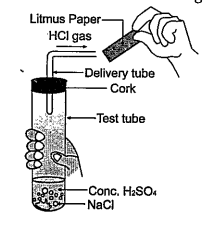Case 2: Chemical reactions are chemical changes in which reactants transform into products by making or breaking of bands (or both) between different atoms. A chemical reaction can be determined with the help of any of the following observations:
Evolution of a gas
Change in temperature
Formation of a precipitate
Change in colour
Change of state
The figure given below represents the experiment carried out between conc. sulphuric acid and sodium chloride, which react with each other to form HCl gas.

Blue litmus paper is brought near the mouth of the delivery tube to check the presence of HCl acid but no change is observed in the colour of litmus paper because :
The litmus paper used is dry.
The litmus paper used is moist.
Blue litmus paper does not change its color with an acid.
The litmus paper is kept very close to the mouth of the delivery tube.
The correct Answer is:A
Similar Questions
Write the chemical equation of the reaction in which the following changes have taken place :
(i) Change in colour
(ii) Change in temperature
Formation of precipitate.View SolutionGive an example of each of the following chemical changes.
A reaction involving (i) change of state (ii) formation of precipitateView Solution
Knowledge Check
- Question 1 - Select One
Which of the following is represent in a chemical change?
ARemain constant in temperatureBChange in colourCEvolution of a gasDBoth b and c - Question 2 - Select One
A chemical reaction is carried out twice with the same quantity of reactants to forms the same products but the pressure is different for the two experiments. Which value does not change?
AkpBHeat releasedCΔTsurroundingsDWork done
State which of the following pertain to - chemical changes.
The change is temporaryView SolutionState which of the following pertain to - chemical changes.
The change is permanentView Solution(a) What is meant by a chemical reaction ? Explain with the help of an example
(b) Given one example each of a chemical reaction characterised by:
(i) evolution of a gas
(ii) change in colour
(iii) formation of a preopitate
(iv) change in temperature
(v) change in state.View SolutionRate of chemical reaction changes in the presence of a .............. .
View SolutionSelect the chemical changes from the following list of changes -
Breaking of glassView SolutionGive an example of a chemical reaction for each of the following situations :
(a) A change in colour is observed .View Solution

